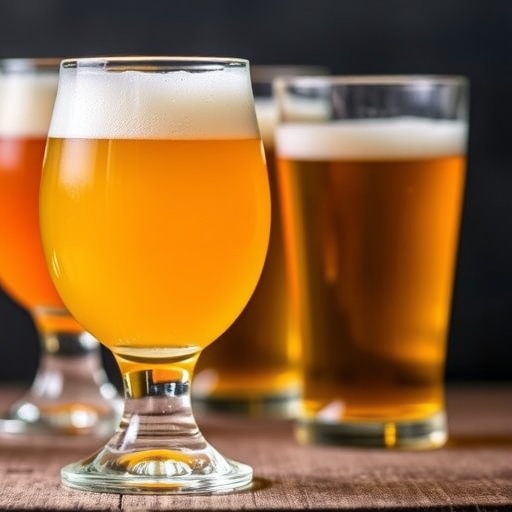Brewer’s spent yeast, a byproduct of brewing, has increasingly garnered attention in the scientific community for its underutilized potential. In the landscape of waste management and sustainable practices, this microorganism emerges not merely as a waste product but as a treasure trove of bioactive compounds and flavorful peptides. Recent research conducted by a team led by Martins, G.S., and published in the journal Waste Biomass Valor, reveals a remarkable richness within these spent yeasts, shedding light on their promise as valuable resources for both food and health industries.
The brewing process generates a substantial amount of spent yeast, which is often discarded or used for animal feed. However, with a better understanding of the bioactive compounds present in these yeasts, researchers are now exploring innovative ways to extract and utilize them. The study conducted by Martins and colleagues delves deep into the complex composition of brewer’s spent yeast and elucidates the bioactive potential of its peptides.
One of the primary findings of the study indicates that brewer’s spent yeast is rich in proteins, which can be hydrolyzed into peptides. These peptides exhibit various biological activities, including antioxidant, antimicrobial, and anti-inflammatory properties. Such bioactivities can have significant implications for human health, suggesting that these peptides could be incorporated into functional foods or dietary supplements aimed at enhancing well-being.
Moreover, the flavor profile of the peptides derived from brewer’s spent yeast cannot be overlooked. The research indicates that these peptides contribute to umami and other savory notes, making them attractive candidates for flavor enhancers in the food industry. By integrating these peptides into food products, manufacturers might not only reduce dependence on synthetic flavorings but also promote sustainable practices by utilizing what was once considered waste.
The extraction process of these peptides from spent yeast requires a delicate approach to ensure that their bioactive properties remain intact. The study thoroughly examines various hydrolysis methods, emphasizing enzymatic hydrolysis as the most effective technique. This method enables the breakdown of proteins into smaller peptides while preserving their functional properties. The team’s analysis of peptide profiles reveals the diversity of these compounds, tantamount to a culinary goldmine waiting to be explored.
In addition to the nutritional and sensory aspects, the study details the potential health benefits associated with consuming these peptides. With a growing global focus on health and wellness, there is a noticeable trend toward more natural ingredients in food products. The bioactive components of brewer’s spent yeast peptides offer a substantiated approach to boosting health, potentially aiding in areas such as immune function, metabolic regulation, and even mental well-being.
Environmental sustainability is another noteworthy angle highlighted in the research. The reuse of spent yeast not only contributes to reducing food waste but also promotes a circular economy within the brewing sector. By converting waste into resourceful products, breweries can enhance their sustainability ratings and appeal to environmentally conscious consumers. This aligns well with global initiatives aimed at minimizing food waste and maximizing resource efficiency.
The implications of this research extend beyond merely enhancing food flavor and health benefits. They underscore a necessary shift towards valuing byproducts that have traditionally been seen as waste. The brewing industry, like many others, is under pressure to innovate sustainably. As regulations regarding waste disposal tighten, embracing technologies that allow for the valorization of byproducts could position these industries favorably in the eyes of consumers and regulatory bodies alike.
Consumer awareness is equally crucial in this equation. As shoppers become more informed and demanding about the sources and sustainability of their food, products that incorporate bioactive peptides sourced from brewer’s spent yeast could become highly desirable. Not only do these products resonate with health-conscious consumers, but they also offer an enticing narrative of sustainability that modern consumers often seek.
Furthermore, this research serves as a launching pad for future studies aimed at exploring the diverse applications of brewer’s spent yeast peptides. The scientific community is poised to investigate other extraction methods, the potential for higher yield, and the examination of more extensive databases on the effects of these peptides on human health. With continued interest in functional foods, the end products derived from this byproduct may soon find a place on retail shelves worldwide.
In conclusion, the study by Martins and colleagues contributes significantly to the understanding of brewer’s spent yeast as a bioactive resource. The dual promise of health benefits and flavor enhancement encapsulated in its peptides offers exciting possibilities. As we transition towards a more sustainable future, recognizing the potential within what we often deem waste could change our approach to both food production and consumption.
Navigating this intersection of flavor, health, and sustainability invites consumers, manufacturers, and researchers alike to rethink the symbiotic relationship we share with our food resources. The journey towards a more sustainable and health-conscious food system is a collective effort, and innovations stemming from the potential within brewer’s spent yeast are a testament to the possibilities that lie ahead.
Subject of Research: Brewer’s spent yeast peptides and their bioactive potential.
Article Title: Bioactive Potential and Flavor Profile of Brewers’ Spent Yeast Peptides.
Article References:
Martins, G.S., de Souza, G.C., Rodrigues, K.P. et al. Bioactive Potential and Flavor Profile of Brewers’ Spent Yeast Peptides. Waste Biomass Valor (2025). https://doi.org/10.1007/s12649-025-03350-9
Image Credits: AI Generated
DOI:
Keywords: Brewer’s spent yeast, bioactive peptides, sustainability, flavor enhancement, health benefits.
Tags: anti-inflammatory effects of yeast peptidesantimicrobial activity of spent yeastantioxidant properties of brewer’s yeastbioactive compounds in brewing byproductsbrewer’s spent yeast peptidesflavor enhancement from yeast peptideshealth benefits of yeast peptidesinnovative uses of brewing wasteprotein hydrolysis in food industryrecycling brewing byproducts for healthresearch on brewer’s yeast applicationssustainable waste management in brewing





